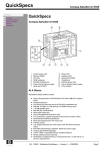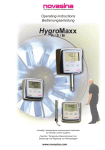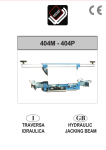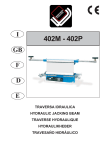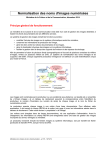Download SERVICE MANUAL - Commercial Catering Spares
Transcript
COMMERCIAL MICROWAVE OVEN EM-S1000 EM-E1000 SERVICE MANUAL CAUTION Before servicing the oven, read the “Safety Precautions” section on page 2 of this manual. SPECIFICATIONS CONTENTS MODEL EM-S1000 Power Source: Max. Output Power: Cavity Size: Overrall Dimensions: Net Weight: 230V AC, 50Hz 1000 watts 0.8 cu-ft 520(W)x412(D)x296(H)mm 17 kgs Model EM-E1000 Power Source: Max. Output Power: Cavity Size: Overall Dimensions: Net Weight: 230V AC, 50Hz 1000 watts 1.0 cu-ft 520(W) x 412(D)x296(H)mm 17 kgs Safety Precautions.......................................................................Cover Installation Instructions ........................................................................2 General Information.............................................................................2 Microwave Radiation Test ...................................................................2 Safety Precautions for Disassembly and Repair.................................3 Description & Function of Components...............................................3 Electrical Operation .............................................................................4 Door & Interlock Adjustments ..............................................................4 Component Test Procedures ...............................................................5 Disassembly & Replacement of Parts.................................................6 Wiring Diagram ...................................................................................9 Schematic Diagram ............................................................................10 Exploded View ..................................................................................11-16 Exploded View Parts List...................................................................17-18 Product Code No. NOTICE EM-S1000 ECO 1-437-602-04 EM-S1000 EUK 1-437-602-05 EM-E1000 This service information is intended for use by a service technician who is familiar with proper and safe procedures to be followed when repairing any electrical or gas appliance and who is equipped with proper tools and testing devices. Repairs covered in this publication and made by uninformed persons can result in hazards developing due to improper assembly or adjustment. While making such repairs, persons not having the proper background may subject themselves to the risk of injury or electrical shock which can be serious or even fatal. A. If the oven is operative prior to servicing, a microwave emission check should be performed prior to servicing the oven. B. Inform the manufacturer, importer, or assembler of any certified oven unit found to have a microwave emission level in excess of 5 mW/cm2. Repair any unit found to have excessive emission levels at no cost to the owner (see 21 CFR 1004.2) and attempt to ascertain the cause of the excessive leakage. The owner of the unit should be instructed not to use the unit until the oven has been brought into compliance. C. If the oven operates with the door open: 1) tell the user not to operate the oven and 2) contact the manufacturer and/or importer and CDRH immediately. D. Remember to connect the monitor switch after replacement and to check interlock/monitor continuity. IMPORTANT NOTE TO THE CONSUMER The manufacturer will not be responsible for injury or property damage arising from service performed by anyone other than authorized Service Centers. If you perform service on your own products, you must assume responsibility for personal injury or property damage which may result. 02-03 REFERENCE NO. SM-2400012 PRECAUTIONS TO BE OBSERVED BEFORE AND DURING SERVICING TO AVOID POSSIBLE EXPOSURE TO EXCESSIVE MICROWAVE ENERGY (a) Do not operate or allow the oven to be operated with the door open. (b) Make the following safety checks on all ovens to be serviced before activating the magnetron or other microwave source and make repairs as necessary: (1 ) Interlock operation, (2) proper door closing, (3) seal and sealing surfaces (arcing, wear, and other damage), (4) damage to or loosening of hinges and INSTALLATION INSTRUCTIONS IMPORTANT: BEFORE THE UNIT IS INSTALLED, INSPECT THE OVEN AND DETERMINE IF ANY OF THE FOLLOWING DAMAGE CONDITIONS EXIST. 1. The door does not close firmly against the door support because the door is warped or the hinge is damaged. 2. Either the door seals or the trim is damaged. 3. If there is any visible damage to the oven. If any of the above conditions exist, DO NOT OPERATE THE OVEN. Call your local authorized service representative. If none of the above conditions exist, proceed with properly installing the oven. A minimum clearance of 3” on both sides and 1” on top and rear must be observed. This will allow proper internal ventilation of the unit. Also, do not remove the legs because of the possibility of restricting the ventilation. WARNING ELECTRICAL GROUNDING INSTRUCTIONS latches, (5) evidence of dropping or abuse. (c) Before turning on microwave power for any service test or inspection within the microwave generating compartments, check the magnetron, waveguide or transmission line, and cavity for proper alignment, integrity, and connections. d) Any defective or misadjusted components in the interlock, monitor, door seal, and microwave generation and transmission systems shall be repaired, replaced, or adjusted by procedures described in this manual before the oven is released to the owner. (e) A microwave leakage check to verify compliance with the Federal performance standard should be performed on each oven prior to release to the owner. Check all code rules and regulations for connecting the appliance to be certain the installation conforms with all local, municipal and state codes as well as local utility regulations. 2. The door seals or door trim are damaged. 3. If there is any visible damage to the oven. Where a two-prong wall receptacle is encountered, it is the personal responsibility of the user to contact a qualified electrician and have it replaced with a properly grounded three-prong wall receptacle in accordance with the National Electrical Codes. DO NOT use a two-prong adapter, since proper grounding is not assured even if the ground wire or metal tab is connected to the outlet box. The use of an extension cord is not recommended. However,if it is necessary to use an extension cord, it must be a type s, with 3 number 14 wires and have a 3 prong grounded plug. The extension cord should not drape over a countertop where it can be pulled on or tripped over accidentally. Under no circumstances should the rounded ground prong be removed from the plug. Failure to comply with the above could result in a serious shock hazard . GENERAL INFORMATION This appliance is equipped with a three-prong grounding plug for your protection against shock hazard and must be plugged directly into a properly grounded receptacle. Use a properly polarized and grounded three hole receptacle as is required by NATIONAL ELECTRICAL CODES on all new construction. NOTE: APPLIANCE MUST BE GROUNDED 3-PRONG GROUNDING PLUG WALL RECEPTACLE POWER SUPPLY CORD WITH 3-PRONG GROUNDING PLUG For the safety of the user, it is required that all major appliances requiring electricity for operation be electrically grounded in accordance with the National Electrical Code ANSI C1-1981. IMPORTANT: BEFORE PROCEEDING, THE FOLLOWING INFORMATION MUST BE CAREFULLY READ TO AVOID POSSIBLE EXPOSURE TO MICROWAVE RADIATION. Before servicing the oven, unplug the oven, remove the cabinet and take a continuity reading of the interlock switches to assure they are operating properly. Refer to the Component Test Section in this service manual. Also, it is very important to insure that the door seals are not damaged. If a microwave leakage instrument is available, check the oven for any possible microwave leakage. Do not operate the oven if the following conditions exist. 1. The door does not close firmly against the door support because of the door being warped or the hinge is damaged. 2 Do not operate the oven if the front frame of the oven is dirty or if the interlocks are loose. Microwave leakage may be present if these conditions exist. Do not operate the oven if: 1. any door gaskets or trim surrounding the oven door or control panel are missing. 2. the waveguide and oven cavity are not intact. 3. the door does not close properly. Avoid operating the oven if known components in the interlock, oven door or microwave generting transmission assembly are defective. They must be replaced. After the above precautions have been taken, proceed with normal repair procedures. Remember that high voltage is present, so use caution to avoid electrical shock. MICROWAVE RADIATION TEST NOTE: A MICROWAVE LEAKAGE CHECK SHOULD BE PERFORMED AFTER ANY REPAIRS OR ADJUSTMENTS HAVE BEEN MADE ON THE DOOR, FRONT FRAME AND/OR INTERLOCK SWITCHES, IMPORTANT: IF THE READING IS OVER 2 mW/cm2, REFER TO THE DOOR AND INTERLOCK ADJUSTMENTS SECTION IN THIS MANUAL. THE DOOR IS DESIGNED FOR LEAKAGE 2 OF LESS THAN 1 mW/cm , ADJUSTMENTS SHOULD BE MADE TO BRING ALL READINGS 2 TO BELOW 1 mW/cm . The microwave leakage measurement equipment manufacturers presently acceptable are NARDA, SIMPSON and HOLADAY. More information on these units can be obtained from the respective equipment manufacturers. TO PERFORM MICROWAVE LEAKAGE CHECK: 1. Fill 275 milliliters or 9 ounces of tap water in a 2 cup measuring cup. 2. Place the container in the center of the oven cavity on the glass tray. 3. Set power control for microwave “Cook” (high) or 100% operation. Set timer for 3 minutes. 4. Close the door securely and start the oven. 5. Perform the proper adjustment and operations check with the microwave leakage meter (refer to the operation instructions with the meter). Check the oven by moving the probe, starting at the top right-hand side of the door, clockwise no faster than one inch per second, back to the starting position. Also, a check over the entire visual screen must be made. no heating power. An open filament lead or “dead” filament transformer will give the same indication as an open filament in the magnetron. This possibility should be eliminated before the magnetron is considered open. (4) INTERNAL PLATE CATHODE SHORT A shorted magnetron will give the same indications as the loss of vacuum. (5) MODING Moding occurs when the magnetron momentarily operates at a different frequency and a higher voltage than designed. Moding results in low heating power. Moding is usually caused by the cathode losing emission characteristics. LOW POWER Low emission will result in low cooking power. Food will require a longer than normal cooking time. It can be detected by a lower than normal water temperature rise. LOW EMISSION Caused by “wearout” of the emission characteristics of the directly heated cathode. The tube current does not get high enough to cause the tube to oscillate with normal line voltage. Everything will appear normal, but the tube will not heat. SAFETY PRECAUTIONS FOR DISASSEMBLY AND REPAIR Probe Speed: One inch per second (max.) IMPORTANT: MICROWAVE LEAKAGE CHECK MUST BE PERFORMED ON THE REAR VENTS AND SIDE VENTS. NOTE: THE METER PROBE MUST BE HELD APPROXIMATELY TWO INCHES FROM THE POINT OF MEASUREMENT. THIS IS ACCOMPLISHED BY THE USE OF A TWOINCH (5 cm) PLASTIC SPACER THAT IS SUPPLIED WITH THE METER. IT IS NORMALLY ATTACHED TO THE PROBE. 6. The maximum allowable microwave leakage level is 5mW/cm2 by government standard. IMPORTANT: IF THE READING IS OVER 2 mW/cm2, REFER TO THE DOOR AND INTERLOCK ADJUSTMENTS SECTION IN THIS MANUAL. THE DOOR IS DESIGNED FOR LEAKAGE 2 OF LESS THAN 1 mW/cm , ADJUSTMENTS SHOULD BE MADE TO BRING ALL READINGS 2 TO BELOW 1 mW/cm . -Cautions to be observed when troubleshooting. Unlike many other appliances, the microwave oven is a high-voltage, high-current piece of equipment. It is completely safe during normal operation. However, carelessness in servicing the oven can result in an electric shock or possible danger from a short circuit. You are asked to observe the following precautions carefully. (1) Always remove the power plug from the outlet before servicing. (2) Use an insulated screwdriver and wear rubber gloves when servicing the high voltage side. (3) Discharge the high voltage capacitor before touching any oven components or wiring. 1. Check the grounding. Do not operate on a 2-wire extension cord. The microwave oven is designed to be used when grounded. It is imperative, therefore, to make sure it is grounded properly before beginning repair work. MAGNETRON FAILURE MODES LOSS OF VACUUM This is a case where the tube has had the vacuum envelope destroyed and air has entered the tube. This will cause internal arcing. With continued use, the transformer will eventually fail and the circuit fuse will blow. OPERATION FAULTS OPEN FILAMENTS A magnetron with an open filament will produce (6) high voltage capacitor. When replacing or checking parts, create a short between oven chassis and the negative high terminal of the high voltage capacitor, by using a properly insulated screwdriver to discharge it. When the 10 Amp. fuse is blown out due to the operation of the monitor switch, replace primary and secondary interlock switches, monitor switch and relay 2. After repair or replacement of parts, make sure that the screws are properly tightened, and all electrical connections are tightened. Do not operate without cabinet. DESCRIPTION & FUNCTION OF COMPONENTS FAN MOTOR The fan motor drives a blower fan which draws cool air through the back of the oven. This cool air is directed through the air ducts surrounding the magnetron tube to cool the magnetron. Some of the air is then exhausted directly through the bottom vents. However, a portion of this air is channeled through the cavity to remove the steam and vapors given off from heating food. OVEN LIGHT The oven light illuminates the interior of the cavity so the food can be visually examined through the door. POWER TRANSFORMER The purpose of the power transformer is to provide the filament voltage for heating the magnetron filaments as well as to produce the high voltage needed for magnetron tube operation. During a cook cycle, the ‚230 Volts AC applied to the primary winding is converted to approximately 3.22 Volts AC on the filament winding. The same 230 Volts AC primary input is converted to approximately 2070 Volts AC on the high voltage secondary winding of the power transformer. CAUTIONS: AFTER REMOVING THE CABINET, DISCHARGE THE CAPACITOR BY PLACING AN INSULATED SCREWDRIVER ACROSS THE TERMINALS. PRIMARY SWITCH (UPPER) INTERLOCK The primary protective switch (interlock) is activated by the latch when the door is closed. The switch, in the open position when the door is open, interrupts the current to the magnetron. Closing the door will close the interlock switch and normal operations can be continued. SECONDARY (LOWER) INTERLOCK SWITCH Short 2. Warning about the electric charge in the high voltage capacitor. For about 60 seconds after the operation stops, an electric charge remains in the 3 The secondary protective interlock switch is located behind the front control panel and is activated when the door is closed. When the door is open, this switch will interrupt the circuit. MONITOR SWITCH (MIDDLE) INTERLOCK This interlock switch disables the control panel if the door is open or the catch is out of adjustment or the primary interlock switch fails. If for some reason the primary switch and secondary switch stick in the closed position and the door were to be opened, the circuit would be shorted through the normally closed safety switch. This would blow the fuse. If there appears to be an interlock switch problem, but the fuse is not blowing, refer to the Component Test Procedure Section in this service manual. NOTE:IF THE INTERLOCK SWITCHES ARE REPLACED, THE CATCH MUST BE ADJUSTED. SEE DOOR AND INTERLOCK ADJUSTMENTS SECTION FOR PROPER ADJUSTMENT PROCEDURE. DEFECTIVE SWITCHES SHOULD BE DESTROYED TO PREVENT POSSIBLE FUTURE USE. IMPORTANT: IF AT ANY TIME THE OVEN FUSE BLOWS DUE TO AN OVEN FAULT, OR THE CIRCUIT BREAKER TRIPS AFTER BEING RESET ONE TIME WITH THE HOUSE CIRCUIT UNLOADED EXCEPT FOR THE OVEN, THE INTERLOCK SWITCHES MUST BE REPLACED AS A GROUP. THIS IS BECAUSE THE SHORT CIRCUIT CURRENTS WILL HAVE DAMAGED THESE IMPORTANT SWITCHES. MAGNETRON THERMAL PROTECTOR The magnetron thermal protector located on the magnetron is designed to prevent an overheated condition in the tube due to fan failure, obstructed air ducts, etc. Under normal operating conditions, the thermal protector remains closed. However, If abnormally high temperatures within the magnetron approach a critical level, the thermal protector will interrupt the circuit to the magnetron. When the magnetron has cooled to a safe operating temperature, the thermal protector closes and a cook (or defrost) cycle can be resumed. HALF-WAVE VOLTAGE DOUBLER CIRCUIT The half-wave rectification circuit consists of a diode package and a single capacitor. The 2070 Volts AC from the high voltage secondary winding is rectified to approximately 3680 Volts DC (peak voltage) needed for magnetron operation. 1. Diode - a diode is a solid state device that allows current flow in one direction, but prevents current flow in the opposite direction. 2. Capacitor - a capacitor is able to store electric energy, as well as pass AC and block DC current. WATER TEMPERATURE RISE CHECK The following procedure should be followed when low power is suspected in the oven but all other operations, including cooking light operation, appear normal. Power output of the magnetron can be measured by performing a water temperature rise check. This test will require a quart glass cup and an accurate mercury thermometer or thermocouple-type temperature tester. For accurate results the following procedure must be followed carefully. 1. Fill a measuring cup with one quart of tap water and measure temperature of the water with a thermometer or thermocouple tester. Stir the temperature probe through the water until the temperature stabilizes. Record the temperature of the water and remove the temperature probe. 2. Place the measuring cup in the oven and put the oven into the cook (high) cycle for exactly two (2) minutes. Allow the water to heat. 3. Remove cup from the oven and again measure temperature making sure to stir the temperature probe through the water until maximum temperature is recorded. 4. Subtract the cold water temperature from the hot water temperature. The result should be 25°F±4°F, or between 21°F to 29°F rise in temperature. If the water temperature is accurately measured and tested for the required time period, the test result will indicate if the magnetron tube has low power output (low rise in water temperature) which would extend cooking time, or high power output (high rise in water temperature) which would reduce cooking time. Because cooking times can be adjusted to compensate for power output, the magnetron tube assembly should be replaced only if the water temperature rise test indicates a power output well beyond the normal limits. This test is only accurate if the power supply line voltage is 120 Volts while the oven is operating. ALTERNATE TEST-METRIC Use same procedure as in preceding paragraphs except as noted. 1. Use 1000 ML water. 2. Timer for two minutes. 3. Same 4. Water temperature will be between 8°F to 12°F higher. ELECTRICAL OPERATION By closing the door, the primary and secondary interlock switches close and monitor switch opens. The closed switches allow line voltage to flow through the 20 amp fuse to interlock to magnetron thermal switch. At this point, line voltage splits and power is applied to primary side of high voltage transformer, oven cavity light, fan motor, and timer. To complete the circuit, two things must happen to energize the above Components. The timer must be set, which will close timer contacts, and the door must be closed, which activates the interlock switches. At this time, line voltage to neutral is applied across high voltage primary, timer, oven light, and fan. The 230 Volt AC input to the primary winding of the power transformer is converted to approximately 2070 Volts AC output from the high voltage secondary winding. At the same time, the filament secondary winding of the power transformer provides 3.32 Volts AC to heat the magnetron filaments. The 2070 Volts AC output from the power transformer high voltage secondary winding is sent to a half-wave doubling circuit comprised of a single diode and capacitor where approximately 4140 Volts DC (peak voltage) is provided to the magnetron tube. The negative 4140 Volts DC applied to the cathode of the magnetron tube causes the 4 magnetron to oscillate and produce the 2450 MHz cooking frequency. The microwave energy produced by the magnetron tube is channeled through a waveguide into the cavity past the diffuser and finally into a cavity where the load is placed to be heated. When the timer has completed the selected cooking time, the timer switch opens. The circuits are open to the light, timer, fan motor, and power transformer, and the microwave energy is no longer produced. Five beeps signal the end of the cook cycle. DOOR & INTERLOCK ADJUSTMENTS DOOR ADJUSTMENTS The door adjustment on all microwave ovens is very important to prevent any excessive leakage. The microwave leakage levels should be checked after all door, interlock switches and associated repairs are made. See the Microwave Radiation Test Section in this manual for proper testing procedures. The following door adjustments must be followed. LATCH & CATCH ASSEMBLY ADJUSTMENTS CAUTION: AFTER REMOVING THE CABINET, DISCHARGE THE CAPACITOR BY PLACING AN INSULATED SCREWDRIVER ACROSS THE TERMINALS. To make proper latch and catch assembly adjustment: 1. Disconnect the power to the unit, remove the cabinet and discharge the capacitor by placing an insulated screwdriver across the terminals. 2. Open the door. 3. Loosen the screws that secure the plastic interlock bracket until the assembly can be moved freely back and forth. 4. Hold the door closed securely. 5. Move the plastic catch toward the door until it stops and door is latched. Next, move the catch toward the back panel making sure it is snug against door latch. Check by opening and closing the door. Using an ohmmeter, place the leads of the meter across the terminals of the monitor switch. As the door is opened, your meter should show a short, as the door is closed it should show an open circuit. 6. Tighten and secure the plastic bracket with screws. 7. To be totally sure that switches are functioning properly, see Primary, Secondary Interlock Switch and Monitor Switch Test Procedures. DO NOT ATTEMPT TO ADJUST INTERLOCK SWITCHES WITH OVEN ENERGIZED. IF THIS WARNING IS NOT OBSERVED, HIGH LEVELS OF MICROWAVE LEAKAGE MAY BE PRESENT. NOTE: Test: Ohmmeter check from MSC to MSNC indicates short circuit. 3. If the switch does not operate as described above, replace all the switches and relay2. Repeat the above tests. cabinet removed, discharge the capacitor with an insulated screwdriver. 2. With alligator clips, connect a meter capable of measuring at least 230V AC, across the input terminals to the transformer. COMPONENT TEST PROCEDURES 230V AC IF THE INTERLOCKS ARE REPLACED, THEY MUST BE ADJUSTED. SEE INTERLOCK ADJUSTMENTS SECTION FOR PROPER ADJUSTMENT PROCEDURE. PRIMARY (UPPER) SWITCH TEST INTERLOCK 1. Disconnect power to the unit. Remove the cabinet and discharge the capacitor. 2. With the ohmmeter set on the RX1 scale, take continuity readings as noted below. A) Condition: Door open Test: Ohmmeter check from LC to MSC indicates open circuit. B) Condition: Door closed Test: Ohmmeter check from LC to MSC indicates short circuit. 3. If the switch does not operate as described above, replace all the switches and relay2. Repeat the above tests. SECONDARY (LOWER) INTERLOCK SWITCH TEST 1. Disconnect power to the unit, remove the cabinet and discharge the capacitor. 2. With the ohmmeter set on the RX1 scale, take continuity readings as noted below. A) Condition: 1)Door open Test: Ohmmeter check from SISC to SISNO indicates open circuit. B) Condition: Door closed Test: Ohmmeter check from SISC to SISNO indicates short circuit. 3. If the switch does not operate as described above, replace all the switches and relay2. Repeat the above tests. WARNING:FOR CONTINUED PROTECTION AGAINST EXCESSIVE RADIATION EMISSION REPLACE ONLY WITH PARTS AS DESCRIBED IN THE PARTS LIST CAUTION: WHEN REPLACING THESE SWITCHES, USE ONLY FACTORY REPLACEMENT PARTS. REPLACING WITH ANY OTHER PART WILL VOID THE WARRANTY AND MAY CAUSE INJURY TO THE USER. HIGH VOLTAGE COMPONENT OPERATIONAL TEST In this section we have tried to lay these tests out in a logical sequence so that you can isolate any suspected high voltage problem. 1. Unplug oven from its power source. 2. After removing the cabinet discharge the capacitor by shorting the two capacitor terminals together with an insulated screwdriver. 3. Visually check the high voltage wiring for proper connections. Refer to wiring diagram for proper wiring sequence. CAUTIONS: HIGH VOLTAGES ARE PRESENT DURING THE COOK (HIGH) CYCLE, SO EXTREME CAUTION SHOULD BE OBSERVED. WHEN TESTS ARE COMPLETE, ALWAYS UNPLUG THE OVEN FROM ITS POWER SOURCE AND DISCHARGE THE CAPACITOR. NOTE: DO NOT TOUCH ANY OVEN COMPONENTS OR WIRING DURING OVEN OPERATION. INTERLOCK POWER TRANSFORMER TESTS TRANSFORMER INPUT VOLTAGE CHECK 1. Disconnect power to the unit. Remove the cabinet and discharge the capacitor. 2. With the ohmmeter set on the RX1 scale, take continuity readings as noted below. A) Condition: Door open Test: Ohmmeter check from MSC to MSNC indicates open circuit. B) Condition: Door closed An operational test can be made in order to determine whether or not primary power is being applied to the transformer. CAUTION: APPROXIMATELY 1840V AC IS PRESENT AT THE HIGH VOLTAGE TERMINAL OF POWER TRANSFORMER DURING COOK CYCLE. OBSERVE CAUTION AT ALL TIMES. 1. With the oven power cord unplugged and MONITOR (MIDDLE) SAFETY SWITCH TEST 5 3. Plug oven in and set for regular cook operation. If all primary circuits are functioning properly, 230V should be applied and measured across transformer. PRIMARY FILAMENT WINDING (CATHODE) 1 2 F LOW VOLTAGE - 3.35V AC FA HIGH CURRENT FILAMENT VOLTAGE CHECK An operational test can be made in order to determine the amount of filament voltage produced by the power transformer. CAUTION: APPROXIMATELY 2070 VOLTS AC ARE PRESENT AT THE HIGH VOLTAGE TERMINAL OF THE POWER TRANSFORMER DURING COOK (HIGH CYCLE). OBSERVE CAUTION AT ALL TIMES. 1. With oven power cord unplugged and cabinet removed, discharge the capacitor with an insulated screwdriver. 2. Remove the high voltage lead that connects the capacitor to the high voltage terminals. NOTE: DURING TEST OPERATION, KEEP METER, HANDS, ETC., WELL AWAY FROM THE HIGH VOLTAGE TERMINALS OF THE POWER TRANSFORMER. 3. With alligator clips, connect a meter capable of measuring up to 10 Volts AC across the magnetron filament terminals. 4. Apply power to the oven and put the oven into cook (high) cycle to get a filament voltage reading. A normal indication should be approximately 2.8 to 3.75 Volts AC. Unplug the oven before disconnecting the meter leads. 5. If a normal 2.8 to 3.75 Volts AC reading was indicated on the meter, go to step 6. 6. If the input voltage is normal, but no filament voltage is present, replace the power transformer. 7. If filament voltage is normal, unplug the power cord, discharge the capacitor, reinstall the high voltage lead and refer to the Magnetron Filament Test. PRIMARY FILAMENT WINDING (CATHODE) F LOW VOLTAGE - 3.35V AC FA HIGH CURRENT 1. Set volt ohmmeter to read ohms using RX10,000 or higher scale. 2. Check resistance between the diode terminals. Reverse leads and check again. There should be considerable difference (minimum of 1/2 of scale) between the two readings, approximately a 10 to 1 ratio. If reversing the leads does not change the reading, replace the diode. The diode may be checked in the unit, but one lead must be removed. Some high impedance vacuum tube (V.T.M.) or solid state (F.E.T.) meters may show an acceptable diode as defective. These meters will normally show high ohms (open) in both lead positions. NOTE: METERS WITH LESS THAN A 6 OR HIGH VOLTAGE WINDING CONTINUITY CHECK - POWER TRANSFORMER One side of the power transformer high voltage secondary winding is connected to oven chassis ground. The other end of the high voltage secondary has one terminal with a red lead. Since approximately 2070 Volts AC are present at the high voltage secondary terminal during a cook (high) cycle, it is not recommended that the high voltage measurements be attempted. Normally, a continuity check of high voltage secondary winding will be sufficient to determine the condition of the secondary winding. 1. With oven unplugged, discharge the capacitor and remove the high voltage lead from the power transformer high voltage secondary terminal. 2. With an ohmmeter set on the RX1 scale, measure the resistance between the high voltage terminal of the power transformer and oven chassis ground. The reading should indicate around 80 ohms. 3. If extremely low resistance is indicated, or if extremely high or infinite resistance is indicated with the continuity test, replace the power transformer. A shorted transformer will blow the fuse. MAGNETRON FILAMENT TEST Disconnect the high voltage leads from the KV MAGNETRON CAPACITOR CHASSIS magnetron filament terminals. Measure the resistance across the two magnetron filament terminals with the ohmmeter set on RX1. If a normal resistance of less than 1 ohm between magnetron terminals is indicated on the meter, make a Power Transformer Test. If high resistance or infinite resistance is indicated between the magnetron terminals, replace the magnetron assembly. DIODE CHECK TRANSFORMER KV MAGNETRON CAPACITOR CHASSIS 9 VOLT BATTERY ARE USUALLY NOT ADEQUATE FOR CHECKING THE FRONT-TOBACK RESISTANCE OF THE DIODE. THE METER SHOULD BE CHECKED WITH A DIODE KNOWN TO BE GOOD BEFORE JUDGING A DIODE TO BE DEFECTIVE BECAUSE OF AN INFINITE RESISTANCE READING IN BOTH DIRECTIONS. If continuity is indicated in both directions, or if an infinite resistance is read in both directions, the diode is probably defective and should be replaced. If the diode check is normal, go to Magnetron Check. CAPACITOR TESTS If the capacitor is open, no high voltage is available to the magnetron. A shorted capacitor normally causes high line current, which should trip the wall circuit breaker or blow the line fuse. An ohmmeter can be used to check for a shorted or open capacitor. 1. With an ohmmeter set on the highest scale, measure the resistance between the two capacitor terminals. The meter should indicate continuity between the terminals for a short time and should indicate an open circuit once the capacitor is charged. Reversing the meter leads should give the same indication. 2. If the ohmmeter indicates continuity between the capacitor terminals at all times, or if no meter deflection occurs at all, the capacitor should be replaced. NOTE: THE OHMMETER SHOULD BE SET ON THE HIGHEST RESISTANCE SCALE WHEN MAKING A CAPACITOR CHECK. CAPACITORS WITH INTERNAL RESISTOR CAN SHOW A RESISTANCE AS LOW AS TWO (2) MEGOHMS. MAGNETRON THERMAL PROTECTOR DIODE TRANSFORMER KV MAGNETRON CAPACITOR CHECKING H.V. DIODES - ALTERNATIVE METHOD DIODE TRANSFORMER DIODE b. If bulb lights normally both ways when leads are reversed, diode is shorted. c. A normal diode will produce a dim light when the leads are placed on the diode in one direction. Before making any checks get a known good diode and make a test for comparison. Many times the diode you check as open is probably good. We have found that many of you are checking them out on the wrong scale of your meter, or that your meter is physically not able to check the H.V. diodes we use in our microwave ovens. We are, therefore, providing an alternate test method for checking diodes in which you do not need a meter. All you need is a jumper cord and a 40 watt light bulb. A simple test set up like this will easily check H.V. diodes. 40W The test procedure is: 1. Connect an alligator clip to each terminal of diode. 2. Plug in cord. a. If the bulb doesn’t light, the diode is open. 6 CHASSIS TEST Unless an overheat condition exists, a continuity check across the thermal protector contacts should indicate a closed circuit. The thermal protector opens at approximately 150-C (302F) if used. DISASSEMBLY & REPLACEMENT OF PARTS CABINET REMOVAL 1. Disconnect the power cord from the wall outlet. 2. Remove the screws from the rear edges of the case. When replacing screws, make sure at least one screw has a star washer or serrated head on it for proper grounding. 3. Slide the cabinet back about one inch. 4. Lift the cabinet from the unit. 2. Remove the screw(s) from capacitor mounting bracket and swing it out of the way. 3. If replacement capacitor is used, replace wire for wire. 4. To reassemble, reverse the above procedure. It is important for high voltage clearance that the capacitor be firmly seated. For proper capacitor testing procedure, see Component Test Procedures. POWER TRANSFORMER REMOVAL NOTE: ALL DISASSEMBLY AND REPLACEMENT OF PARTS BEGINS WITH THE CABINET REMOVED. CAUTION: UNPLUG THE OVEN AND DISCHARGE THE CAPACITOR BEFORE REMOVING ANY OF THE COMPONENTS. IMPORTANT: DO NOT OPERATE THE OVEN IF: - THE DOOR DOES NOT FIT PROPERLY. - THE WAVEGUIDE AND OVEN ARE NOT INTACT. - THE R-F GASKET IS MISSING. (THE R-F GASKET IS LOCATED AROUND THE DOME OF THE MAGNETRON TUBE TO PREVENT ANY LEAKAGE BETWEEN THE MAGNETRON TUBE AND THE WAVEGUIDE.) HIGH VOLTAGE DIODE REMOVAL 1 . Discharge the capacitor by shorting across each terminal. 2. Remove one lead from capacitor. 3. Remove screw which holds other lead with offset screwdriver. 4. Replace wire for wire, if replacement is used. (Observe proper diode polarity.) The arrow on diode should point to the capacitor bracket. 5. To reinstall, reverse above procedure. FAN ASSEMBLY REMOVAL 1 . Disconnect the two lead wires from the fan motor. 2. Remove fan shroud by removing shroud mounting screws. 3. Remove the two motor assembly mounting screws secured to the back cabinet. 4. The entire fan assembly can then be removed. 5. Remove the fan blade by pulling the fan blade from the motor shaft. 6. To reassemble and install, reverse the above procedure. Be sure to glue the fan 1. Unplug the power cord, remove the outer case and discharge the capacitor. 2. Disconnect all the leads to the transformer, primary, secondary and filament. Remove the support bracket at the top of the transformer. 3. Remove mounting screws from the underside of the chassis that fastens the transformer and lift the transformer out. 4. To reinstall, reverse the above procedure. It is important that screws be tight since they are the ground return for the high voltage winding. REMOVAL OF THE OVEN SOCKET/ LIGHT BULB LIGHT 1. Unplug the power cord. Remove the outer cabinet and discharge the capacitor. 2. Remove the socket/bulb mounting screw. 3. Remove socket/bulb assembly. Remove wires from socket/ bulb terminals. NOTE: BULB IS PART OF SOCKET AND MUST BE REPLACED AS AN ASSEMBLY. 4. Replace wires on terminals of new socket and replace socket/bulb by reinstalling the mounting screw. REPLACING THE FUSE IMPORTANT: IF THE 10 AMP FUSE BLOWS, REFER TO THE TESTING PROCEDURE. DO NOT REPLACE IT UNTIL THE PROBLEM IS CORRECTED. ALSO, IF AT ANY TIME THE OVEN FUSE BLOWS DUE TO AN OVEN FAULT, OR THE CIRCUIT BREAKER TRIPS AFTER BEING RESET ONCE WITH THE HOUSE CIRCUIT UNLOADED (EXCEPT FOR THE OVEN), THE INTERLOCK SWITCHES MUST BE REPLACED AS A GROUP. THIS IS BECAUSE THE SHORT CIRCUIT WILL HAVE DAMAGED THESE IMPORTANT SWITCHES. SEE INTERLOCK SWITCH REMOVAL. NOTE: IF INTERLOCKS HAVE BEEN REPLACED, IT IS VERY IMPORTANT TO MAKE A MICROWAVE LEAKAGE CHECK OF THE DOOR. SEE THE MICROWAVE LEAKAGE SECTION IN THIS MANUAL. Noise Filter THE NOISE FILTER blade onto the motor shaft. CAPACITOR REMOVAL 1. Discharge the capacitor. 7 1. Unplug the power cord, remove the outer cabinet and discharge the capacitor. 2. Remove the fuse. 3. A blown fuse can be diagnosed with an ohmmeter. 4. Replace with a 10 Amp fuse. NOTE: USE ONLY A NORMAL-BLOW 20 AMP TUBULAR CERAMIC FUSE SUCH AS THE LITTELFUSE 3140120 20A. DO NOT USE A SLOW BLOW FUSE. INTERLOCK AND MONITOR SWITCH REMOVAL If for any reason one of the interlock switches fail, all three must be replaced as a group. 1. Unplug the power cord, remove the outer cabinet and discharge the capacitor. Open the door. 2. Remove the air guide from the front side of the magnetron. The air guide is secured to the right side of the oven cavity with a 2 piece plastic pin. 3. The switches are all mounted on a single plastic bracket and are held in position with plastic tabs. 4. Remove screws holding plastic switch bracket to oven chassis. 5. After the switch bracket has been removed, the tabs can be seen. By applying slight pressure, the switch will release from the switch bracket. 6. Remove switches and replace wire for wire. Reverse above to reinstall. CAUTION: WHEN REPLACING THE INTERLOCK SWITCHES, BE SURE THE MOUNTING TABS ARE NOT BROKEN, BENT OR OTHERWISE DEFICIENT IN THEIR ABILITY TO PROPERLY RETAIN THE INTERLOCK SWITCHES. IMPORTANT: DO NOT OPERATE THE OVEN UNTIL THE INTERLOCKS ARE PROPERLY ADJUSTED. SEE DOOR AND INTERLOCK ADJUSTMENTS SECTIONS. IMPORTANT: THE INTERLOCK SWITCHES MUST MEET STRICT FEDERAL REQUIREMENTS FOR RELIABLE OPERATION. IT IS EXTREMELY IMPORTANT THAT ANY QUESTIONABLE SWITCHES BE REPLACED WITH THE EXACT SAME TYPE OBTAINED FROM THE FACTORY SERVICE PARTS DIVISION. DEFECTIVE SWITCHES MUST BE RENDERED INOPERATIVE BY TWISTING ONE OF THE TERMINALS. TURNTABLE OR STIRRER AND DRIVE REMOVAL MOTOR 1. Unplug the power cord, remove the outer cabinet and discharge the capacitor. 2. Remove the glass tray and plastic turntable assembly from the oven cavity. (MODEL EM-E1100) 3. Turn the oven upside down. Remove the motor access cover. Upon initial service, the cover, which is an integral part of the bottom plate, must be cut free. Use wire cutters to cut the 4 integral tabs. Be careful of sharp edges. 4. Remove the 2 screws securing the motor. Withdraw the motor and disconnect the 2 lead wires from the motor. 5. Reverse the above procedure to reinstall new parts., note the following: 6. Replace the motor access cover by engaging the long tab into the slot provided on the bottom plate and secure the other end with an M4 self tapping screw. DOOR ASSEMBLY REMOVAL 1. Disconnect power from the unit, remove the cabinet and discharge the capacitor. 2. Open the door and carefully remove the choke cover. Remove door. 3. Reverse the above procedure to install the new door assembly. 4. The microwave sealing strips located on the door must not be removed or damaged. NOTE: AFTER REPAIRS HAVE BEEN MADE, IT IS VERY IMPORTANT TO MAKE A MICROWAVE LEAKAGE CHECK OF THE DOOR. SEE THE MICROWAVE RADIATION TEST SECTION IN THIS MANUAL. mal protector terminals. 3. Remove the thermal protector mounting screw. 4. Remove the thermal protector. 5. Reverse procedure to replace. CONTROL PANEL ASSEMBLY REMOVAL AND REPLACEMENT MAGNETRON ASSEMBLY REMOVAL 1. Unplug the power cord. remove the cabinet and discharge the capacitor. Open the door. 2. Remove screw securing control panel to front of oven chassis. 3. To reassemble, reverse the above process. If provided, be sure to reinstall the green ground wire under screw. 1. Unplug the power cord, remove the cabinet and discharge the capacitor. 2. Remove the air guides and thermal protector from the magnetron. ELECTRONIC CONTROLLER ASSEMBLY REMOVAL CHOKE COVER DOOR PLASTIC HINGE WASHER IMPORTANT: AFTER THE DOOR HAS BEEN REPLACED, THE INTERLOCKS MUST BE ADJUSTED PROPERLY. SEE INTERLOCK ADJUSTMENTS SECTION BEFORE OPERATING THE OVEN. 1. Disconnect power from the unit. Remove the cabinet and discharge the capacitor. 2. Remove screw at top that holds the control panel to the oven chassis. 3. Controller can be replaced by removing screws through rear of control panel and replacing with new control, wire for wire. Reverse above steps to reinstall. 4. NOTE: The only replaceable parts on the controller are the complete PCB assembly and the keyboard assembly. No other parts are available. 5. When replacing a keyboard assembly, be sure to attach it to the PCB panel. THERMAL PROTECTOR REMOVAL 1. Unplug the power cord, remove the outer cabinet and discharge the capacitor. 2. Disconnect the connectors from the ther- 8 3. Remove the four magnetron mounting screws from the side of oven cavity. 4. Disconnect wire leads from magnetron and replace on new magnetron, wire for wire. 5. Reverse the above procedure to reinstall new magnetron and reassemble. NOTE: DO NOT LOSE SCREWS, THEY ARE M4 METRIC. IMPORTANT: DO NOT OPERATE THE OVEN WITH THE MAGNETRON DISASSEMBLED FROM THE WAVEGUIDE. IMPORTANT: MAKE SURE WIRE GASKET IS PRESENT BEFORE INSTALLING MAGNETRON. AC230V 50Hz 9 Ground Fuse 10A TP2 TP4 Noise Filter Unit TP1 TP3 Wiring Diagram TP2 TP1 TP7 TP6 1 3 CN2 CL Fan Relay 2 MAG BM Blower Motor INR Relay 1 Relay 2 Relay 3 Secondary Interlock Switch COM Relay 3 T/T Motor TT COM Relay 1 Cavity Light NC Primary Oven Thermal Interlock Monitor Switch Switch Switch Inrush Resistor 1 2 3 CN1 4 5 6 7 8 9 MGT Thermal Switch Key Board Transfer HV Fuse Capacitor Conditions: Door Diode Closed Magnetron 10 EM-S1000 2 1 2 11 10 5 7 6 14 7 3 13 4 12 9 7 - 11 - 8 EM-E1000 2 1 2 11 10 5 7 15 6 7 3 13 14 4 12 16 9 7 - 12 - 8 EM-S1000 & EM-E1000 5 3 4 1 2 2 2 6 15 8 7 25 24 13 21 16 19 9 25 22 10 20 14 23 11 17 2 18 12 - 13 - EM-S1000 & EM-E1000 1 3 5 6 4 2 3 - 14 - EM-S1000 & EM-E1000 4 3 8 5 2 1 7 6 This illustration for reference only. Door Assembly must be replaced. No individual parts are available except items 1, 3, 7 and 8. - 15 - EM-S1000 & EM-E1000 4 6 3 2 1 5 - 16- Parts List for EM-S1000 Page No. Service Code P11 1 MO-M1206 P11 2 JT1T4x8 P11 3 MO-A0760 P11 4 MO-R0790 P11 5 MO-R0791 P11 6 MO-E0240 P11 7 MO-S0075K P11 8 MO-S1137 P11 9 4x8 PCTC P11 10 MO-S0795K187 P11 11 3x6 PSTC P11 12 432-0-2210-06200-A P11 13 MO-E0231 P11 14 4x8DC1TN P13 1 MO-G1854 P13 2 4x8 TSTC/S P13 3 MO-S0795K187 P13 4 MO-E0081 P13 5 3x6 PSTC P13 6 MO-M1044 P13 7 MO-S0688 P13 8 MO-S0555 P13 9 MO-R0439 P13 10 MO-M0993 P13 11 MO-S0856 P13 12 MO-S0954 P13 13 MO-S0603 P13 14 MO-R0235N P13 15 MO-S1126 P13 16 4x8 HCTC P13 17 MO-R0471 P13 18 MO-S0557A P13 19 MO-R0625S P13 20 MO-R0653 P13 21 MO-S1109 P13 22 MO-S1110 P13 23 MO-S1109 P13 24 4x8 TB1TN/C P13 25 4x8 TC1TC P14 1 MO-S1140 P14 2 5x10 HCTC P14 3 MO-M1063 P14 4 MO-R0546 P14 5 MO-R0765 P14 6 4x8 TSTC/B P14 7 MO-S1138 P14 8 4 x 8 TCITC P15 1 MO-A0795 P15 2 MO-A0499 P15 3 MO-R0606 P15 4 MO-E0179 P15 5 MO-R0626 P15 6 MO-M1018 P15 7 MO-D2290 P15 8 4X5 TRUSS B1 P16 1 MO-D2289 P16 2 MO-S1119 P16 3 MO-A0780 P16 4 MO-M1186 P16 5 MO-M1187 P16 6 3x8 BBTC Name Body Screw Cavity Assy Cover (R) Cover (L) Mica Plate Rivet Gear Motor [ T/T motor ] Screw Oven Thermostat Screw Stirrer Assy Shelf Assy Screw Power Supply Cord Screw M.G.T Thermostat Thermo Sheet Screw M.G.T. Guide Noise Filter Fuse 250V 10A Fan Casing Capacitor Holder Capacitor Diode Motor Complete [ Fan Motor ] Fan Magnetron Screw Air Guide Lamp 240V 20W Switch Bracket Switch Lever Primary Interlock Switch Interlock Monitor Switch Door Switch Screw Screw Transformer Screw Bottom Plate Foot (R) Foot (F) Screw Cement Resistor Screw Door Assy Door Main Frame Assy Choke Cover Door Inner Film Door Hook Door Spring Handle Tapping Screws Control Plate [Switch Panel] Keyboard PCB Complete [ PCB Main board ] Decoration Plate D Decoration Plate E Screw 17 Qty 1 5 1 1 1 1 6 1 2 1 4 1 1 2 1 5 1 2 4 1 1 1 1 1 1 1 1 1 1 4 1 1 1 1 1 1 1 2 8 1 2 1 2 2 4 1 1 1 1 1 1 1 1 1 2 1 1 1 1 1 3 Factory Code No. MO-M1206 JT1T4x8 MO-A0760 MO-R0790 MO-R0791 MO-E0240 MO-S0075K MO-S1137 4x8 PCTC MO-S0795K187 3x6 PSTC 432-0-2210-06200-A MO-E0231 4x8DC1TN MO-G1854 4x8 TSTC/S MO-S0795K187 MO-E0081 3x6 PSTC MO-M1044 MO-S0688 MO-S0555 MO-R0439 MO-M0993 MO-S0856 MO-S0954 MO-S0603 MO-R0235N MO-S1126 4x8 HCTC MO-R0471 MO-S0557A MO-R0625S MO-R0653 MO-S1109 MO-S1110 MO-S1109 4x8 TB1TN/C 4x8 TC1TC MO-S1140 5x10 HCTC MO-M1063 MO-R0546 MO-R0765 4x8 TSTC/B MO-S1138 4 x 8 TCITC MO-A0795 MO-A0499 MO-R0606 MO-E0179 MO-R0626 MO-M1018 MO-D2290 4X5 TRUSS B1 MO-D2289 MO-S1119 MO-A0780 MO-M1186 MO-M1187 3x8 BBTC Parts List for EM-E1000 Page No. Service Code P11 1 MO-M1207 P11 2 JT1T4x8 P11 3 MO-A0761 P11 4 MO-R0790 P11 5 MO-R0791 P11 6 MO-E0241 P11 7 MO-S0075K P11 8 MO-S1028 P11 9 4x8 PCTC P11 10 MO-S0795K187 P11 11 3x6 PSTC P11 12 MO-R0688 P11 13 MO-R0674 P11 14 MO-R0689 P11 15 MO-S0563 P11 16 MO-R0132 P13 1 MO-G1854 P13 2 4x8 TSTC/S P13 3 MO-S0795K187 P13 4 MO-E0081 P13 5 3x6 PSTC P13 6 MO-M1044 P13 7 MO-S0688 P13 8 MO-S0555 P13 9 MO-R0439 P13 10 MO-M0993 P13 11 MO-S0856 P13 12 MO-S0954 P13 13 MO-S0603 P13 14 MO-R0235N P13 15 MO-S1126 P13 16 4x8 HCTC P13 17 MO-R0471 P13 18 MO-S0557A P13 19 MO-R0625S P13 20 MO-R0653 P13 21 MO-S1109 P13 22 MO-S1110 P13 23 MO-S1109 P13 24 4x8 TB1TN/C P13 25 4x8 TC1TC P14 1 MO-S1140 P14 2 5x10 HCTC P14 3 MO-M1063 P14 4 MO-R0546 P14 5 MO-R0765 P14 6 4x8 TSTC/B P14 7 MO-S1138 P14 8 4 x 8 TCITC P15 1 MO-A0795 P15 2 MO-A0499 P15 3 MO-R0606 P15 4 MO-E0179 P15 5 MO-R0626 P15 6 MO-M1018 P15 7 MO-D2290 P15 8 4X5 TRUSS P16 1 MO-D2289 P16 2 MO-S1119 P16 3 MO-A0780 P16 4 MO-M1186 P16 5 MO-M1187 P16 6 3x8 BBTC Name Body Screw Cavity Assy Cover (R) Cover (L) Mica Plate Rivet Gear Motor [ T/T motor ] Screw Oven Thermostat Screw Coupling Rilling Arm Roller Shelf [ Glass Tray ] Special Washer [ Thrust Washer ] Power Supply Cord Screw M.G.T Thermostat Thermo Sheet Screw M.G.T. Guide Noise Filter Fuse 250V 10A Fan Casing Capacitor Holder Capacitor Diode Motor Complete [ Fan Motor ] Fan Magnetron Screw Air Guide Lamp 240V 20W Switch Bracket Switch Lever Primary Interlock Switch Interlock Monitor Switch Door Switch Screw Screw Transformer Screw Bottom Plate Foot (R) Foot (F) Screw Cement Resistor Screw Door Assy Door Main Frame Assy Choke Cover Door Inner Film Door Hook Door Spring Handle Tapping Screws Control Plate [Switch Panel] Keyboard PCB Complete [ PCB Main board ] Decoration Plate D Decoration Plate E Screw 18 Qty 1 5 1 1 1 1 6 1 2 1 4 1 1 3 1 1 1 5 1 2 4 1 1 1 1 1 1 1 1 1 1 4 1 1 1 1 1 1 1 2 8 1 2 1 2 2 4 1 1 1 1 1 1 1 1 1 2 1 1 1 1 1 3 Factory Code No. MO-M1207 JT1T4x8 MO-A0761 MO-R0790 MO-R0791 MO-E0241 MO-S0075K MO-S1028 4x8 PCTC MO-S0795K187 3x6 PSTC MO-R0688 MO-R0674 MO-R0689 MO-S0563 MO-R0132 MO-G1854 4x8 TSTC/S MO-S0795K187 MO-E0081 3x6 PSTC MO-M1044 MO-S0688 MO-S0555 MO-R0439 MO-M0993 MO-S0856 MO-S0954 MO-S0603 MO-R0235N MO-S1126 4x8 HCTC MO-R0471 MO-S0557A MO-R0625S MO-R0653 MO-S1109 MO-S1110 MO-S1109 4x8 TB1TN/C 4x8 TC1TC MO-S1140 5x10 HCTC MO-M1063 MO-R0546 MO-R0765 4x8 TSTC/B MO-S1138 4 x 8 TCITC MO-A0795 MO-A0499 MO-R0606 MO-E0179 MO-R0626 MO-M1018 MO-D2290 4X5 TRUSS MO-D2289 MO-S1119 MO-A0780 MO-M1186 MO-M1187 3x8 BBTC



















